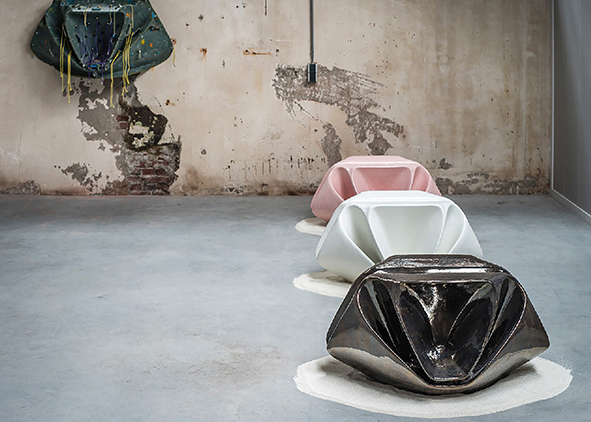Creare legami digitali con i materiali di terra. Il T-Stool
DOI:
https://doi.org/10.19229/2464-9309/10212021Parole chiave:
ceramica, struttura e design, gemello digitale, stampaggio a pressa, stampi in gomma siliconicaAbstract
Il contributo descrive le modalità di concettualizzazione di un processo ceramico finalizzato a creare un nuovo legame tra la ceramica e i suoi stampi attraverso le tecnologie digitali, le cui interazioni sono tentacolari. La sperimentazione su uno sgabello, illustrata dal paper, mira a valorizzare la forza vitale della materia nel processo di design: la fabbricazione del T-Stool, frutto di una collaborazione interdisciplinare, è ottenuta con lo sviluppo di una nuova tecnica di pressatura del gres che impiega uno stampo composto da due parti, in gomma siliconica e in resina epossidica. Il T-Stool è stato realizzato grazie all’impiego di un gemello digitale come fonte di dati per valutare le deformazioni del materiale impiegato e per implementare l’uso di strumenti personalizzati.
Downloads
##plugins.generic.articleMetricsGraph.articlePageHeading##
Riferimenti bibliografici
Bechthold, M., Kane, A. and King, N. (2015), Ceramic Material Systems – In Architecture and Interior Design, Birkhäuser, Basel.
Bennett, J. (2010), Vibrant Matter – A Political Ecology of Things, Duke University Press, Durham (US).
Canguilhem, G. (1992), “Machine and Organism”, in Crary, J. and Kwinter, S. (eds), Incorporations, Zone Books, New York.
Carty, W. M. (2019), Energy in Terra Cotta – The Balance Between Heat Storage and Strength, lecture in Architectural Ceramic Assemblies Workshop, August 12, 2019. [Online] Available at: archceramicworkshop.com/lectures/ [Accessed 05 November 2021].
Easterling, K. (2021), Medium Design – Knowing How to Work on the World, Verso, London.
Fisher, J. (2005), “Making the Link – Persuasion and Permanence”, in Reijnders, A. and European Ceramic Work Center (eds), The Ceramic Process – A Manual and Source of Inspiration for Ceramic Art and Design, University of Pennsylvania Press, Philadelphia, pp. 7-9.
Garcia, T. (2014), Form and Object – A Treatise on Things, Edinburgh University Press, Edinburgh.
Gorter, H. (2005), “Material method and process”, in Reijnders, A. and European Ceramic Work Center (eds), The Ceramic Process – A Manual and Source of Inspiration for Ceramic Art and Design, University of Pennsylvania Press, Philadelphia, pp. 17-21.
Grieves, M. W. (2019), “Virtually Intelligent Product Systems – Digital and Physical Twins”, in Flumerfelt, S., Schwartz, K. G., Mavris, D. and Briceno, S. (eds), Complex Systems Engineering – Theory and Practice, American Institute of Aeronautics and Astronautics, Reston (US), pp. 175-200. [Online] Available at: doi.org/10.2514/5.9781624105654.0175.0200 [Accessed 26 October 2021].
Haraway, D. J. (2016), Staying with the Trouble – Making Kin in the Chthulucene, Duke University Press, Durham (US).
Harman, G. (2011), The Quadruple Object, Zero Books, Winchester (UK).
Iten, C. (2008), “Ceramics Mended with Lacquer – Fundamental Aesthetic Principles, Techniques and Artistic Concepts”, in Herbert, F. and Johnson Museum of Art (eds), Flickwerk – The Aesthetics of Mended Japanese Ceramics, Museum für Lackkunst, pp. 18-24. [Online] Available at annacolibri.com/wp-content/uploads/2013/02/Flickwerk_The_Aesthetics_of_Mended_ Japanese_Ceramics.pdf [Accessed 05 November 2021].
May, J. (2017), “Everything Is Already an Image”, in Log, n. 40, pp. 9-26. [Online] Available at: jstor.org/stable/26323867 [Accessed 26 April 2021].
Reijnders, A. and European Ceramic Work Center (eds) (2005), The Ceramic Process – A Manual and Source of Inspiration for Ceramic Art and Design, University of Pennsylvania Press, Philadelphia.
Russo, R. and Mueller-Russo, K. (2012), “Textiles – Alternate Forms of Malleability”, in Studies in Material Thinking, vol. 7, pp. 1-9. [Online] Available at: materialthinking.org/sites/default/files/papers/SMT_V7_P9_ Russo_and_Russo.pdf [Accessed 26 April 2021].
Sentance, B. (2004), Ceramics – A World Guide to Traditional Techniques, Thames & Hudson, London.

##submission.downloads##
Pubblicato
Come citare
Fascicolo
Sezione
Licenza
AGATHÓN è pubblicata sotto la licenza Creative Commons Attribution License 4.0 (CC-BY).
License scheme | Legal code
Questa licenza consente a chiunque di:
Condividere: riprodurre, distribuire, comunicare al pubblico, esporre in pubblico, rappresentare, eseguire e recitare questo materiale con qualsiasi mezzo e formato.
Modificare: remixare, trasformare il materiale e basarti su di esso per le tue opere per qualsiasi fine, anche commerciale.
Alle seguenti condizioni
Attribuzione: si deve riconoscere una menzione di paternità adeguata, fornire un link alla licenza e indicare se sono state effettuate delle modifiche; si può fare ciò in qualsiasi maniera ragionevole possibile, ma non con modalità tali da suggerire che il licenziante avalli l'utilizzatore o l'utilizzo del suo materiale.
Divieto di restrizioni aggiuntive: non si possono applicare termini legali o misure tecnologiche che impongano ad altri soggetti dei vincoli giuridici su quanto la licenza consente di fare.
Note
Non si è tenuti a rispettare i termini della licenza per quelle componenti del materiale che siano in pubblico dominio o nei casi in cui il nuovo utilizzo sia consentito da una eccezione o limitazione prevista dalla legge.
Non sono fornite garanzie. La licenza può non conferire tutte le autorizzazioni necessarie per l'utilizzo che ci si prefigge. Ad esempio, diritti di terzi come i diritti all'immagine, alla riservatezza e i diritti morali potrebbero restringere gli usi del materiale.


















































































